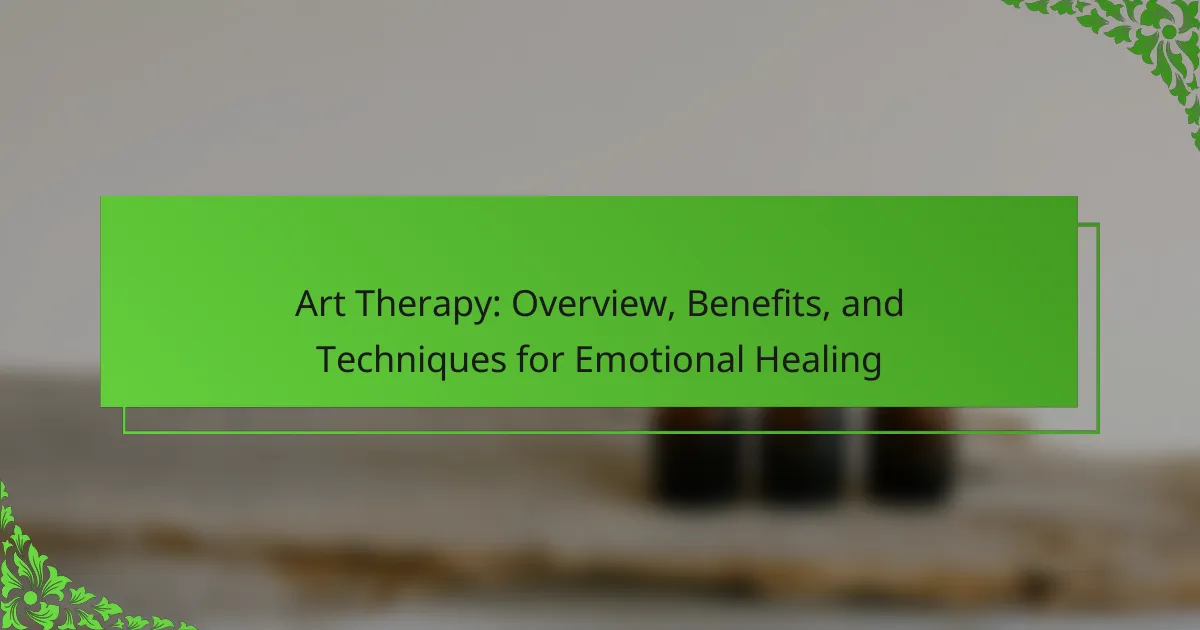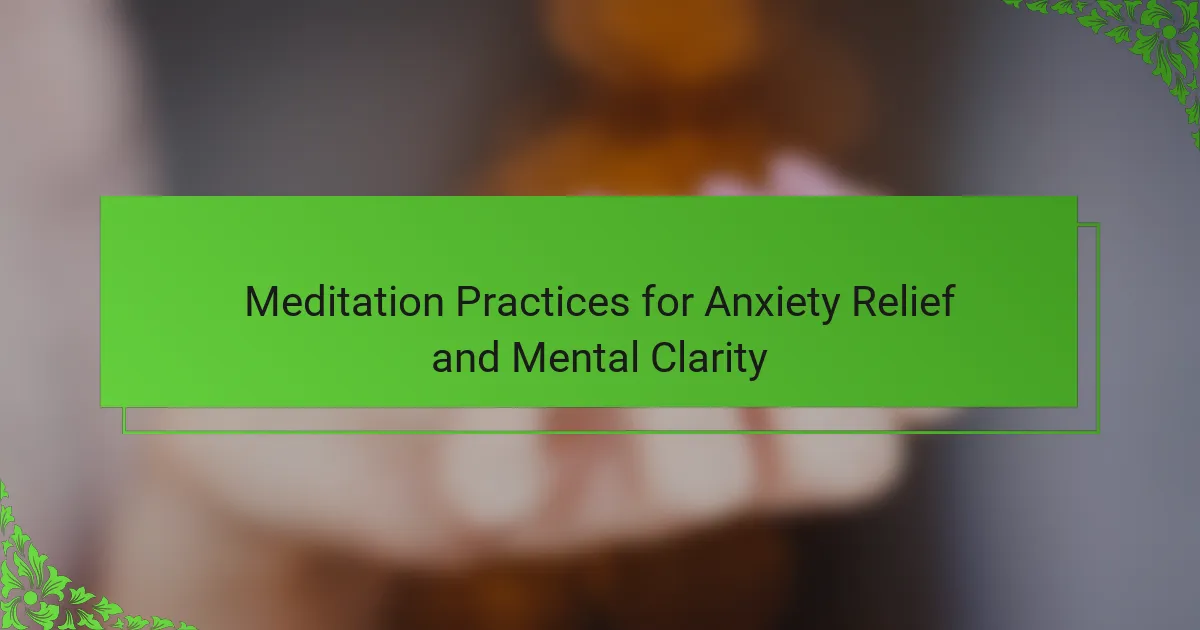Art therapy provides a powerful avenue for emotional healing through creative expression. It emphasizes the therapeutic relationship, the process of creation, and the use of art as a communication tool. The benefits include enhanced emotional expression, stress reduction, and improved self-esteem. Techniques such as drawing, painting, and guided imagery facilitate personal insight and resilience.
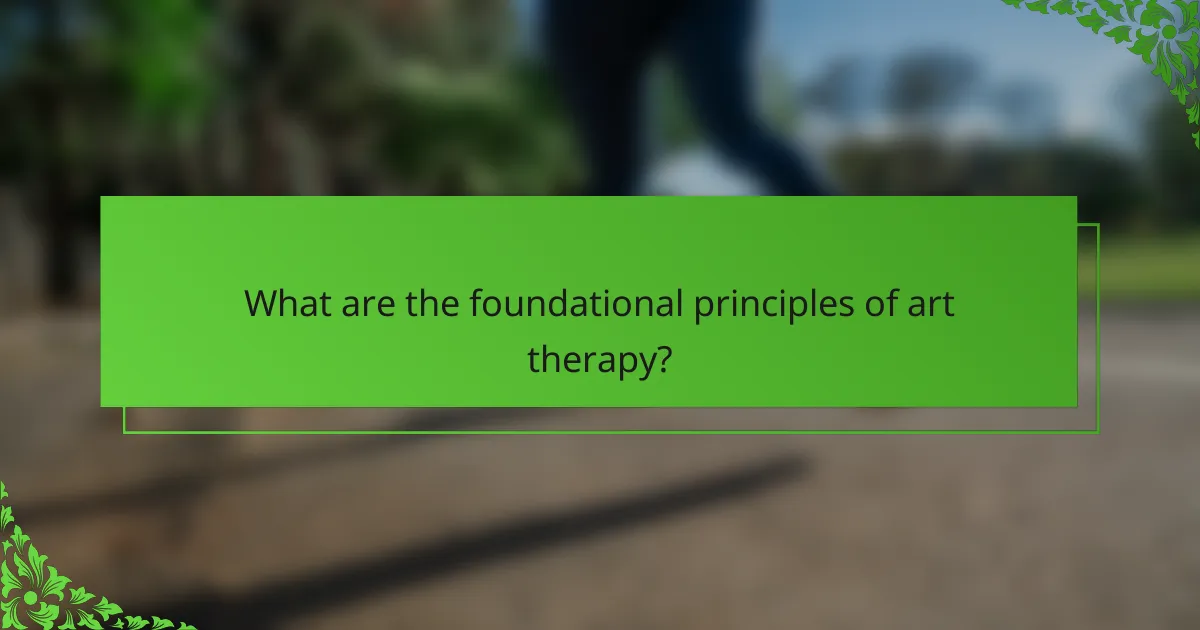
What are the foundational principles of art therapy?
Art therapy is grounded in principles that promote emotional healing through creative expression. Key foundational principles include the therapeutic relationship, the use of art as a communication tool, and the focus on the process of creation rather than the final product.
The therapeutic relationship emphasizes trust and safety, allowing clients to explore emotions freely. Art serves as a non-verbal medium, enabling individuals to express feelings that may be difficult to articulate. Additionally, focusing on the creative process encourages self-discovery and personal insight, fostering emotional resilience.
Incorporating these principles, art therapy can effectively address various mental health challenges, enhancing overall well-being.
How does art therapy facilitate emotional expression?
Art therapy facilitates emotional expression by providing a safe space for individuals to convey feelings through creative processes. This non-verbal approach allows participants to explore emotions that may be difficult to articulate.
Art therapy encourages self-discovery and personal insight, often leading to enhanced emotional awareness. Techniques such as drawing, painting, or sculpting enable individuals to externalize their inner experiences, promoting healing and emotional release.
Moreover, art therapy can reduce anxiety and improve mood, making it an effective tool for emotional regulation. Participants often report feeling a sense of relief and empowerment after engaging in artistic expression.
In summary, art therapy serves as a powerful medium for emotional expression, facilitating healing through creativity and self-exploration.
Why is creativity important in the healing process?
Creativity is crucial in the healing process as it fosters self-expression and emotional release. Engaging in art therapy allows individuals to explore feelings, reduce anxiety, and improve overall mental well-being. Studies show that creative activities can enhance brain function and promote resilience, making them effective tools in emotional healing. Art therapy uniquely combines creativity with therapeutic techniques, facilitating deeper connections to personal experiences and traumas.
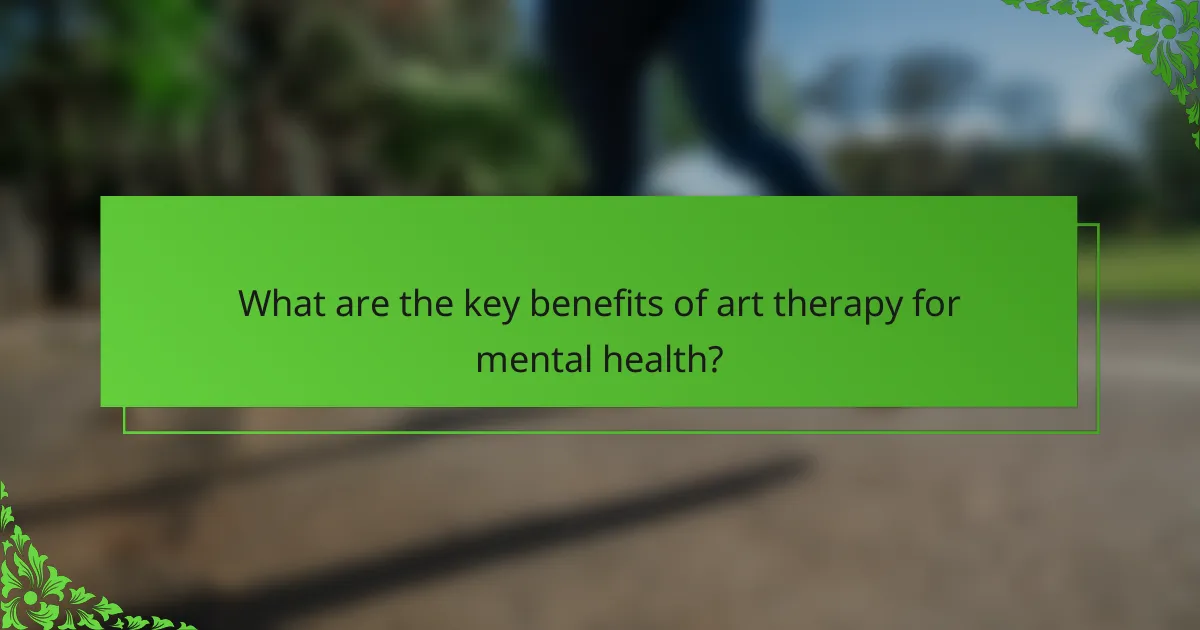
What are the key benefits of art therapy for mental health?
Art therapy offers numerous benefits for mental health, including emotional expression, stress reduction, and improved self-esteem. It allows individuals to explore feelings through creative processes, fostering healing and personal insight. Participants often experience enhanced communication skills and a greater sense of control over their emotions. Additionally, art therapy can serve as a valuable tool for trauma recovery, enabling individuals to process difficult experiences in a safe environment.
How does art therapy improve emotional well-being?
Art therapy significantly enhances emotional well-being by fostering self-expression and reducing anxiety. Engaging in creative activities allows individuals to process emotions, gain insight, and develop coping strategies. Research indicates that art therapy can lower stress levels and improve mood by promoting relaxation and mindfulness. Additionally, it provides a safe space for individuals to explore complex feelings, facilitating healing and personal growth.
Which populations benefit most from art therapy?
Individuals with mental health issues, trauma survivors, children with emotional difficulties, and seniors can benefit most from art therapy. This therapeutic approach enhances emotional expression and promotes healing through creative processes. Research indicates that art therapy can reduce symptoms of anxiety and depression, particularly in these populations. Additionally, it fosters social connections and improves self-esteem, making it effective for diverse groups facing emotional challenges.
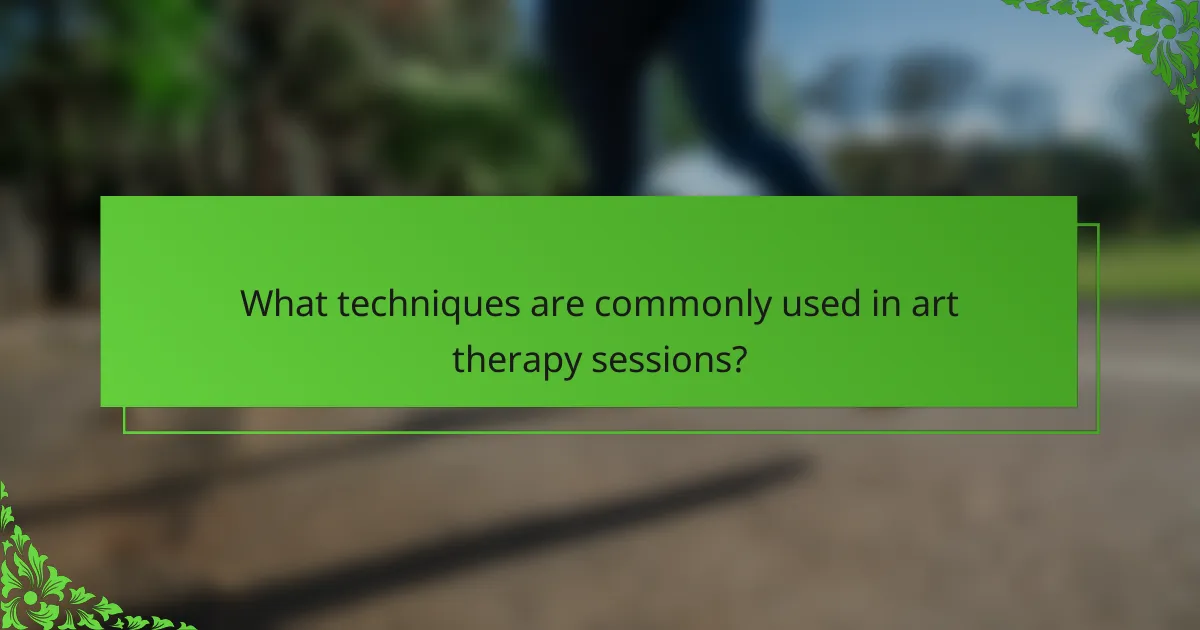
What techniques are commonly used in art therapy sessions?
Art therapy sessions commonly utilize techniques such as drawing, painting, sculpting, and collage-making. These methods facilitate self-expression and emotional processing. Additionally, guided imagery and art-based storytelling enhance therapeutic engagement. Techniques may vary based on individual needs and therapeutic goals.
How does guided imagery enhance the therapeutic experience?
Guided imagery significantly enhances the therapeutic experience by promoting relaxation and facilitating emotional expression. This technique allows individuals to visualize positive scenarios, which can lead to reduced anxiety and improved mental clarity. Moreover, it fosters a deeper connection to the art-making process, enabling clients to explore their feelings through creative expression. Studies indicate that incorporating guided imagery in art therapy can increase engagement and lead to more profound therapeutic outcomes.
What role does color play in art therapy?
Color plays a crucial role in art therapy by influencing emotions and facilitating expression. Different colors evoke specific feelings, aiding clients in processing their emotions. For instance, warm colors like red can stimulate energy, while cool colors like blue promote calmness. This dynamic allows therapists to tailor sessions based on individual needs, enhancing emotional healing. Additionally, color choices can reveal insights into a client’s psychological state, making it a powerful tool in therapeutic settings.
Which mediums are most effective in art therapy?
Visual art forms, such as painting, drawing, and sculpture, are the most effective mediums in art therapy. These mediums allow for self-expression and emotional exploration. Painting can evoke feelings and memories, while drawing provides a way to communicate complex emotions. Sculpture offers a tactile experience that can enhance the therapeutic process. Each medium has unique attributes that facilitate different aspects of emotional healing, making them valuable tools in therapy.
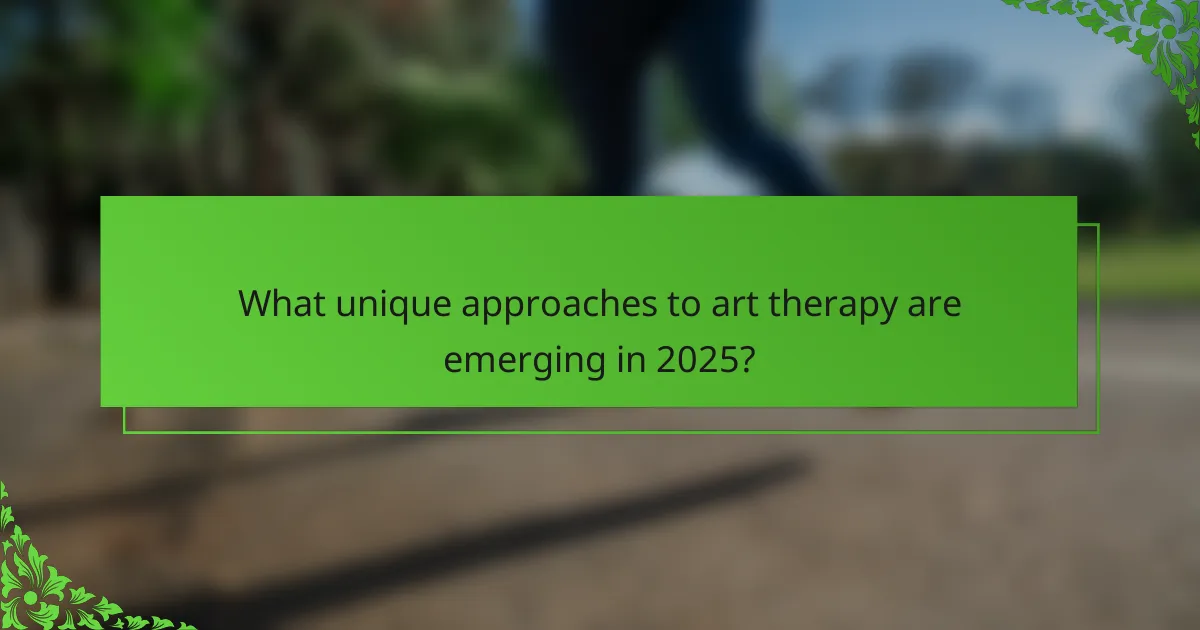
What unique approaches to art therapy are emerging in 2025?
In 2025, unique approaches to art therapy focus on digital integration, community-based practices, and neurodiversity. Digital platforms enable remote sessions, enhancing accessibility. Community art projects foster social connections, promoting collective healing. Additionally, therapies tailored for neurodiverse individuals emphasize personalized expression, allowing for diverse communication methods.
How are digital tools transforming art therapy practices?
Digital tools are revolutionizing art therapy by enhancing accessibility and engagement. These technologies facilitate remote sessions, allowing therapists and clients to connect regardless of location. Virtual platforms offer diverse creative options, such as digital painting and interactive art applications, which can expand therapeutic techniques.
Moreover, data analytics can track progress and emotional responses, providing therapists with valuable insights. Tools like virtual reality create immersive experiences, enabling clients to explore emotions in a safe environment. The integration of these digital tools fosters a more personalized approach to emotional healing through art therapy.
What innovative techniques are being developed for specific conditions?
Art therapy is evolving with innovative techniques tailored for specific conditions. Techniques such as guided imagery, expressive arts, and digital art therapy are being developed to enhance emotional healing. These methods provide unique avenues for individuals to express their feelings and cope with trauma. For example, digital art therapy allows for interactive engagement, which can be particularly beneficial for those with mobility issues. Additionally, art therapy is being integrated with cognitive behavioral approaches to address anxiety and depression more effectively.
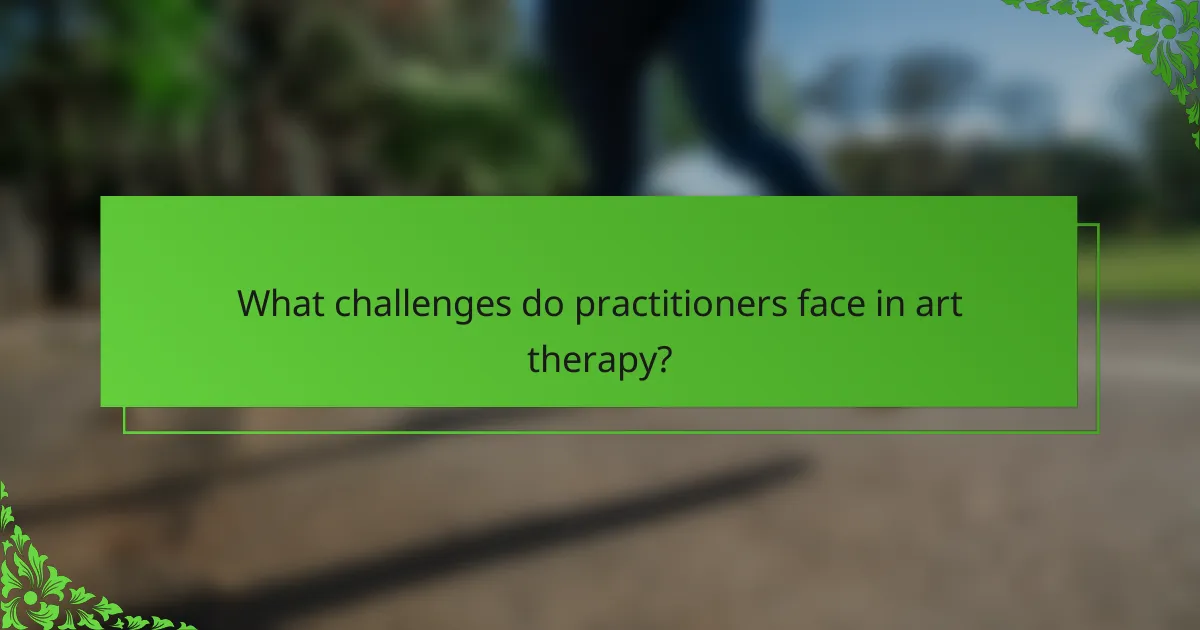
What challenges do practitioners face in art therapy?
Practitioners in art therapy face challenges such as client resistance, emotional distress, and the need for tailored approaches. Managing diverse client backgrounds complicates sessions. Additionally, practitioners must navigate limited resources and seek ongoing professional development to enhance their skills. These factors can impact the effectiveness of therapy.
How can art therapists address resistance in clients?
Art therapists can address resistance in clients by fostering a safe, non-judgmental environment. They utilize creative expression to facilitate communication and explore emotions. Techniques include gentle encouragement, validating feelings, and gradually introducing challenging themes. Building trust is essential for overcoming resistance and promoting emotional healing.
What ethical considerations are important in art therapy?
Ethical considerations in art therapy include confidentiality, informed consent, and cultural sensitivity. Practitioners must ensure clients feel safe expressing themselves. Respecting diverse backgrounds enhances therapeutic effectiveness. Additionally, therapists should avoid dual relationships to maintain professional boundaries. These principles foster trust and promote healing.
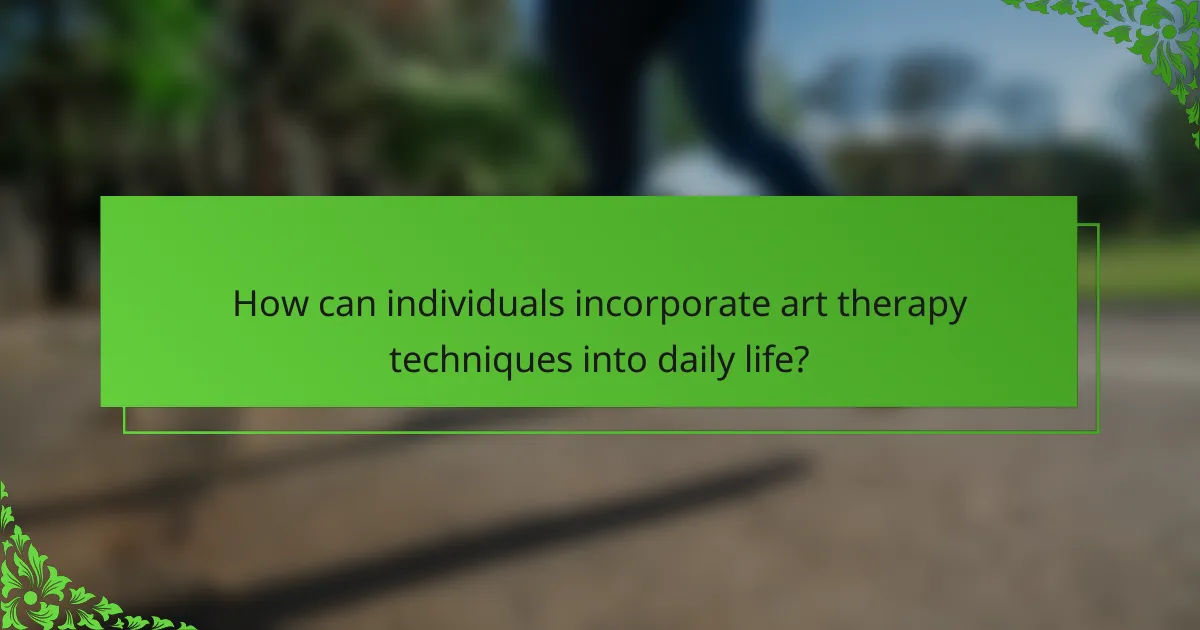
How can individuals incorporate art therapy techniques into daily life?
Individuals can incorporate art therapy techniques into daily life by engaging in creative activities that promote emotional expression. Simple practices include drawing, painting, or journaling to process feelings. Setting aside time for these activities fosters mindfulness and self-reflection. Group art sessions can enhance social connections, providing support and shared experiences. Additionally, using art prompts can inspire creativity and help individuals explore thoughts and emotions. Regularly integrating these techniques can lead to improved mental well-being and emotional healing.
What are some practical exercises for self-expression?
Art therapy offers various practical exercises for self-expression. Engaging in these activities can enhance emotional healing and personal insight.
1. **Drawing or Painting**: Create art without focusing on skill. Use colors and shapes to express feelings.
2. **Collage Making**: Assemble images and words from magazines that resonate emotionally. This visual representation can clarify thoughts and experiences.
3. **Journaling**: Write freely about emotions and experiences. This can help articulate feelings and identify patterns.
4. **Dance or Movement**: Use body movement to express emotions. Dance can release tension and foster joy.
5. **Clay Modeling**: Shape clay to represent feelings or experiences. This tactile activity can be grounding and therapeutic.
6. **Guided Imagery**: Visualize a peaceful place or situation and express that through art. This technique can promote relaxation and self-awareness.
Which resources can support personal art therapy journeys?
Art therapy journeys can be supported by various resources including books, online courses, therapy apps, community workshops, and professional therapists. These resources enhance emotional healing through structured guidance and creative expression.
Books like “The Art Therapy Sourcebook” provide foundational knowledge and techniques. Online platforms such as Skillshare offer courses that teach specific art therapy methods. Therapy apps like “Moodnotes” encourage self-reflection and creativity. Community workshops provide social support and shared experiences. Engaging with professional therapists ensures personalized guidance tailored to individual needs.
What common mistakes should be avoided in self-directed art therapy?
Avoiding common mistakes in self-directed art therapy enhances its effectiveness. Key pitfalls include neglecting emotional safety, setting unrealistic expectations, and failing to reflect on the process. Participants should create a safe space where they feel comfortable expressing emotions. Setting achievable goals fosters a positive experience. Regular reflection on artwork and feelings promotes deeper understanding and emotional healing.
